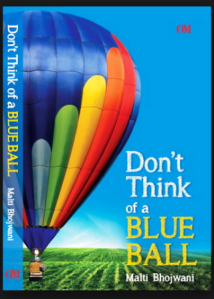Don’t Think of a Blue Ball
The intriguing book title piques curiosity and slight defiance. “And just why,” you humph to yourself as you gaze at the cover, “should I not think of a blue ball.” Scanning a brief review, you decide that it could be helpful reading; its genre, after all, is self-help. If you are not a stranger to the subject, your question is “Why should I buy another book on the same topic?” Well, it begins interestingly with an ending.
A Familiar Premise
Don’t Think of a Blue Ball is anchored on the concept of the law of attraction. Recurrent thoughts and intense feelings draw your reality. When you change them and tap into the universal consciousness, you can create a new reality.
- You draw on your mind’s canvass, the scenes of the life you want
- You draw like a magnet, the people, resources, and events that will bring that life into being.
The title is a demo of the mind’s ability to instantaneously draw an image. I read the words “blue ball” and the object flashed unbidden in my mind, before the other word “Don’t” sunk in … or in spite of it. I sheepishly conjure a large eraser to clear the image. Clever! I console myself.
Since the early 1900s, a number of authors of theosophy, New Thought, healing, mental science, meditation, success/prosperity mindset, and personal development have written volumes about the law of attraction. In 2006, spurned by huge media interest from Oprah Winfrey among others, Rhonda Byrne’s documentary film, The Secret, re-introduced the law of attraction in a big way. Decades prior, Napoleon Hill, visionary author of books on success, wealth, and self-improvement, wrote about the wisdom of the sixth sense in “Think and Grow Rich.” This, he believes, is where the mind of man contacts the universal mind.
A Fresh Approach
Author and certified life coach, Malti Bhojwani, boldly presents an age old concept inDon’t Think of a Blue Ball (DTBB) but does so in a disarmingly direct manner. By utilizing language that is clear and relevant, Malti succeeds in producing vivid mental images which the reader can associate with abstract principles to better understand them. These principles can be applied in common life situations such as:
- Struggles with weight, health, confidence issues;
- Doubts with starting a business; uncertainty in finances/career;
- Overcome with regret and fear in relationships;
- Getting stuck in resentment and non-forgiveness;
- Habits of laziness and boredom.
Malti draws from neuro-linguistic programming and life coaching to deliver the book’s message. She then, switches over to get a readers’ perspective. By reliving her own personal life challenges, she slips into their shoes and checks for obstacles at the receiving end of the message.
Your Vital Take Away
DTBB brings up little resistance because it is not pedantic or preachy. It talks of everyday situations in the lives of everyday people and uses common objects and relevant analogy to explain mental and emotional processes. This simple approach is deliberate. Why? Unless you apply the principles, those thick written volumes you read on the law of attraction will remain just impressive mainstays on your bookshelf. DTBB factors in impact from congruence, gratitude, forgiveness, the highest good of all concerned, and my personal challenge – accept not knowing. Gently inspiring prose and strong imperative tones alternate throughout. The book’s vital parting shot – stop reading already and start practicing!
Don’t Think of a Blue Ball ends with a beginning.
http://wordsmithluwee.com/2013/09/04/dont-think-of-a-blue-ball-it-begins-with-an-ending/


This can be certainly one of certainly the most popular article.